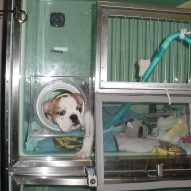According to scientists at Cornell University and University of Wisconsin, the recent canine influenza outbreak affecting more than 1,000 dogs in Chicago, IL and other parts of the Midwest is been identified to be caused by a different strain of Canine Influenza Virus (CIV) than was earlier assumed. Initially, this CIV outbreak was thought to be due to H3N8 (which was originally identified in at a Greyhound track in Florida back in 2004).
Currently, Cornell’s Veterinary Diagnostic Laboratory has done additional testing and found that the current outbreak is being caused by a virus closely related to Asian strains of Influenza A H3N2 viruses. While this specific Canine Influenza virus isn’t transmissible to humans, it has currently in wide circulation in southern Chinese and South Korean dog populations. The H3N2 virus hasn’t been previously identified in North America, suggesting a recent introduction from the virus from Asia. Unfortunately, H3N2 appears to be more virulent (more aggressive) than H3N8.
When this recent Chicago outbreak happened, clinical samples (nasal and oropharyngeal swaps from affected dogs) were sent to the New York State Animal Diagnostic Laboratory at Cornell, where the virus was diagnosed as Influenza A. Additional testing was done and suggested a new strain. As a result, subsequent testing, which was performed in conjunction with the Wisconsin Veterinary Diagnostic Laboratory, identified the new subtype as H3N2. The National Veterinary Services Laboratories, based out of Ames, IA (where USDA’s Animal and Plant Health inspection Services or APHIS service is) is sequencing two isolates from this outbreak to further characterize it.
Regardless of which strain of Canine Influenza Virus it is, clinical signs seen can include:
- Lethargy
- Fever
- Inappetance
- Anorexia
- Coughing
- Increased respiratory rate
- Difficulty breathing
- Nasal discharge
- Blue-tinged gums
- Constant panting
- Exercise intolerance
As an FYI for cat owners, the Canine Influenza Virus H3N2 has caused infection and respiratory illness in cats too. If your dog was recently diagnosed with CIV during this outbreak in the MidWest, make sure to keep your cat isolated or away just in case.
For veterinarians who are seeing cases suspicious of CIV, here are some general recommendations:
- Ideally see affected patients in one specific exam room towards the end of the day (e.g., away from routine healthy appointments)
- When seeing cases, make sure to admit them into isolation for treatment and evaluation
- Identify and implement syndromic surveillance measures that identify high-risk patients.
- Use appropriate disinfectant in the area to prevent further spread.
- Decontaminate potentially contaminated equipment (eg, thermometer, stethoscope)
- Use appropriate barrier protection (e.g., gowns, gloves, etc.)
- Instruct all to wash hands thorough with a biocidal soap and water.
- Consider advanced diagnostic testing [e.g., Influenza A matrix reverse transciptase-polymerase chain reaction assay (Rt-PCR)]. Note that the canine-specific Influenza A H3N8 Rt-PCR in use in several laboratories will not detect this virus, and specific testing must be performed. An H3N2-specific serologic assay is under development and will be available soon.
As for this outbreak, consider appropriate isolation and prevention. Avoid dog parks, groomers, doggy daycares, etc. in the MidWest region until this CIV outbreak ceases. As for protection, talk to your veterinarian about the CIV vaccine. While it’s not known if the current Canine Influenza Virus will offer protection against this different strain, it may offer some cross-protection. This vaccine does protect against H3N8, which may still be in circulation in some areas.
When in doubt, if your dog is showing any signs of coughing, retching, increased respiratory rate, etc., please seek veterinary attention immediately. The sooner you go, the sooner treatment can be implemented!
References:
1. Kang YM, Kim HM, Ku KB, et al. H3N2 canine influenza virus causes severe morbidity in dogs with induction of genes related to inflammation and apoptosis. Vet Res. 2013: 3;44:92.
2. Rishniw, M. Canine Influenza Medical FAQs. VIN 2015.



No Comments
Trackbacks/Pingbacks